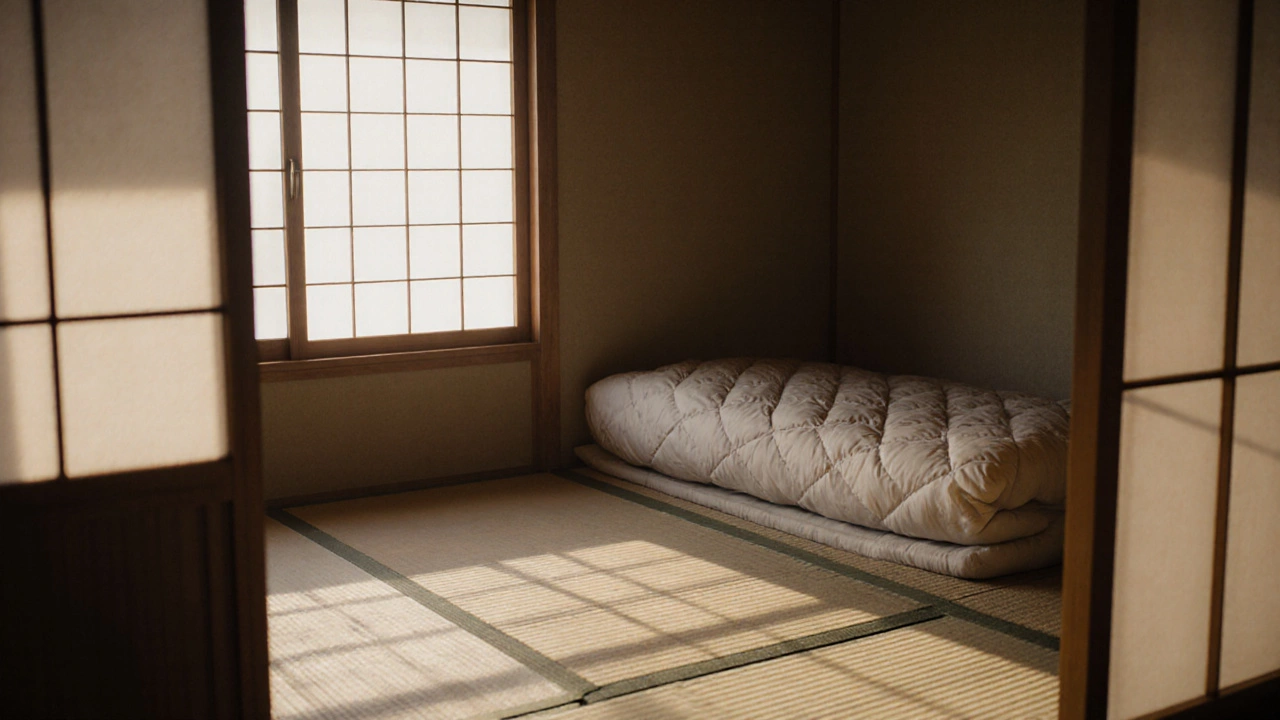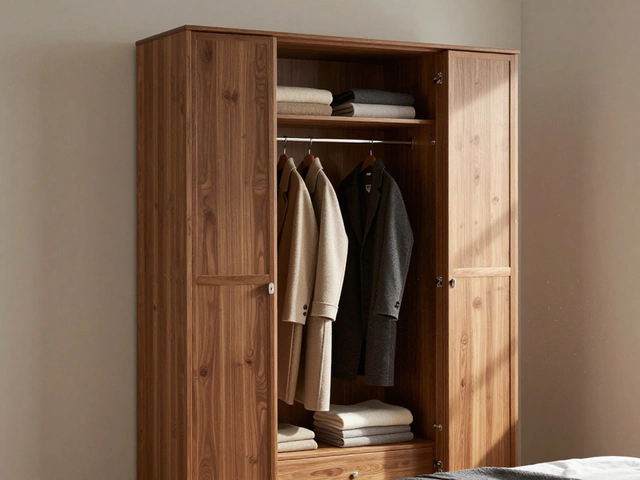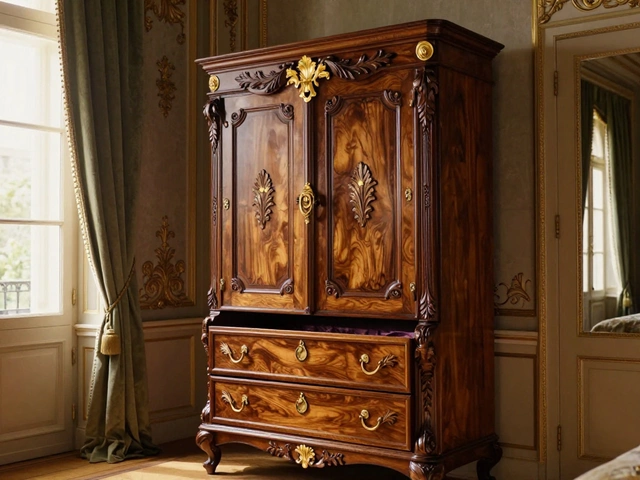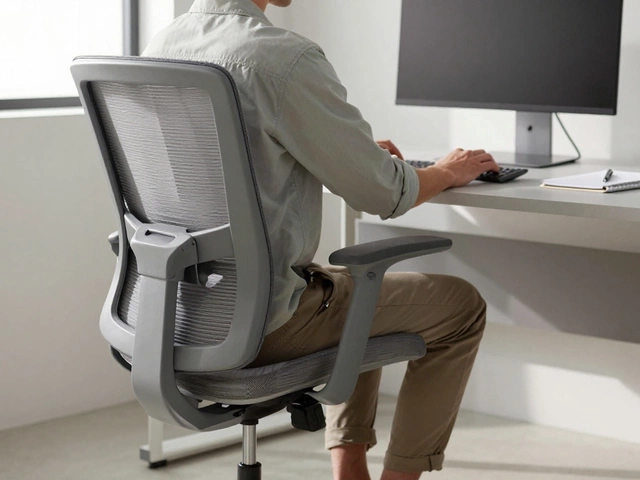Back Health Bedding Calculator
This calculator helps determine if Japanese-style firm bedding might benefit your back health. Based on your height, weight, and pain level, it provides a personalized recommendation.
Most people in North America sleep on big, soft mattresses high off the floor. But in Japan, millions sleep on thin pads directly on the floor. This isn’t just a trend-it’s a centuries-old system built for space, comfort, and health. If you’ve ever wondered what Japanese bedding is, it’s not just about the mattress. It’s a whole way of sleeping that includes the floor, the pad, the cover, and even how you store it.
Japanese bedding isn’t one thing-it’s a system
When people say "Japanese bedding," they’re not talking about a single product. It’s a complete setup: a thin mattress called a futon, a cotton or wool cover called a shikibuton, a pillow called a makura, and a woven straw mat called a tatami underneath. All of it is designed to be rolled up and stored away during the day.
This isn’t just for small apartments. Even in large Japanese homes, bedrooms often double as living rooms. Sleeping on the floor frees up space. By morning, you roll up the futon, tuck it into a closet, and the room becomes a living area. No need for a permanent bedroom. No bulky bed frame. Just clean, open space.
Westerners often think Japanese bedding is hard or uncomfortable. But the truth? Many Japanese people say they sleep better on it. Why? Because it keeps your spine aligned. There’s no sink-in effect like with memory foam. Your body gets even support from the floor and the firm mattress. It’s not about hardness-it’s about balance.
The futon: more than just a mattress
The core of Japanese bedding is the futon. But it’s not like the fold-out sofa futon you might find in a Canadian dorm room. Japanese futons are thick, quilted pads filled with cotton, wool, or sometimes synthetic fibers. They’re usually 3 to 5 inches thick-firm enough to support your spine, soft enough to feel comfortable.
Modern Japanese futons are often machine-washable. Some even have removable covers. The filling is breathable, which helps regulate temperature. In summer, it stays cool. In winter, layered blankets keep you warm without overheating. Unlike Western mattresses that trap heat, Japanese futons let air circulate.
One key difference: Japanese futons are never left on the floor. They’re aired out every day. People hang them on balconies or racks to dry in the sun. Sunlight kills dust mites and keeps the bedding fresh. In humid cities like Tokyo or Osaka, this isn’t optional-it’s essential.
Tatami mats: the foundation
Underneath the futon, you’ll often find tatami mats. These are traditional Japanese floor mats made from rice straw and covered with soft rush grass. They’re not just decorative-they’re functional. Tatami provides a slight cushion, absorbs moisture, and gives a natural, earthy smell to the room.
Each tatami mat is a standard size: about 3 feet by 6 feet. Rooms are measured by how many mats they hold. A "four-and-a-half tatami" room is a common bedroom size in Japan. Tatami is also naturally antimicrobial and regulates humidity. In a country with high rainfall and humidity, that’s a big deal.
But here’s the catch: tatami is delicate. You can’t walk on it with shoes. You can’t drag heavy furniture across it. That’s why Japanese furniture is low and light. And why futons are rolled up, not pushed around.
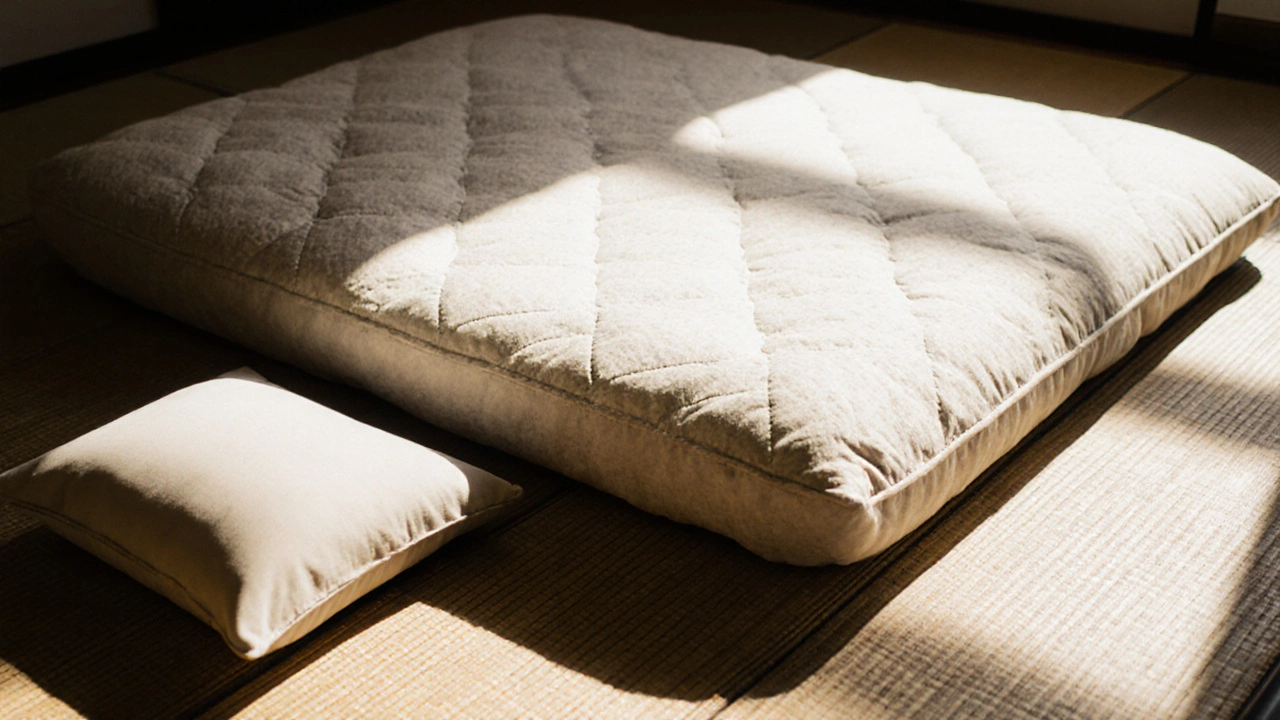
Why do Japanese people sleep on the floor?
It’s not just tradition. There are real reasons why this system works.
- Space efficiency: Apartments in Tokyo average just 500 square feet. A bed takes up too much room. A futon stores away.
- Temperature control: Floors stay cooler in summer. In winter, you layer blankets. No need for central heating.
- Back health: Studies from Osaka University found that people sleeping on firm surfaces had less lower back pain than those on soft mattresses.
- Hygiene: Daily airing reduces dust mites and mold. In a humid climate, this matters more than you think.
- Minimalism: Japanese culture values simplicity. A clutter-free bedroom reduces stress.
It’s also tied to daily ritual. Rolling up the futon each morning is a small act of order. It signals the end of rest and the start of the day. Many Japanese people say it helps them mentally separate sleep from activity.
Can you use Japanese bedding outside Japan?
Yes-and more people are trying it. In cities like Toronto, Vancouver, and Mississauga, small-space living is rising. Millennials and Gen Z renters are looking for alternatives to bulky beds. Japanese bedding offers a solution.
You don’t need tatami mats to start. You can put a futon directly on a hardwood or laminate floor. Or use a thin foam pad underneath for extra cushion. Many online stores now sell Japanese-style futons with cotton filling and washable covers. Prices range from $150 to $400, depending on thickness and material.
Some people combine it with a low wooden frame-just a few inches off the ground-to make getting in and out easier. Others use it in guest rooms. It’s perfect for visitors who want a simple, clean sleeping surface.
But there’s a learning curve. If you’re used to sinking into a cloud-like mattress, the firmness can feel strange at first. Give it two weeks. Your body adjusts. Many users report deeper sleep and less morning stiffness.
What you need to get started
You don’t need to buy everything at once. Start with the basics:
- A futon mattress: Look for 3-5 inch thickness, natural cotton or wool filling, and a removable cover.
- A pillow: Japanese pillows are flat and firm-often filled with buckwheat hulls or foam. They support the neck without tilting the head too far.
- A blanket or quilt: Layer one or two depending on season. Cotton or wool works best.
- A storage solution: A closet shelf, under-bed bin, or wall-mounted rack keeps it tidy.
Optional: a thin foam underlay if your floor is cold or uneven. Or a tatami-style mat if you want the full experience.
Don’t try to replicate the Japanese setup exactly if it doesn’t fit your life. Adapt it. Use it in a studio apartment. Try it in a home office that doubles as a guest room. The goal isn’t to live like a Japanese person-it’s to borrow what works.

Common mistakes people make
People who try Japanese bedding and quit usually make one of these mistakes:
- Buying a too-thin futon: Anything under 2 inches won’t support your spine. Go for at least 3 inches.
- Leaving it on the floor all day: Without airing, moisture builds up. Even in dry climates, roll it up and let it breathe daily.
- Using a regular Western pillow: Tall pillows tilt your neck. Try a low, firm one.
- Expecting instant comfort: It takes time. Your back might ache for a few days as it adjusts.
- Trying to use it on carpet: Carpet traps heat and moisture. Hard floors work best.
If you’re serious about trying it, start small. Use the futon for one week in your guest room. See how you feel. If you sleep better, move it to your main room.
Who benefits most from Japanese bedding?
It’s not for everyone-but it’s perfect for:
- People living in small apartments or studios
- Those with chronic back pain who need spinal alignment
- Minimalists who hate clutter
- People in humid climates who struggle with mold or dust mites
- Anyone curious about sleep habits from other cultures
If you’re someone who spends hours rearranging your bedroom, or who hates the feeling of being "trapped" in a big bed, Japanese bedding might be the reset you need.
Is Japanese bedding good for your back?
Yes, for many people. Sleeping on a firm, flat surface keeps your spine in a neutral position. Unlike soft mattresses that let your hips sink, Japanese futons provide even support. A 2022 study from the University of Tokyo found that participants with lower back pain reported 30% less discomfort after switching to a firm futon for four weeks.
Can you use Japanese bedding on a bed frame?
You can, but it defeats the purpose. Japanese bedding is designed for the floor. If you put a futon on a high bed frame, you lose the space-saving benefit and the natural alignment. If you want a low bed, use a platform frame just 4-6 inches off the ground. That still keeps the feel of floor sleeping.
Do Japanese people use box springs?
No. Box springs are not part of Japanese bedding. They’re seen as unnecessary and bulky. The futon rests directly on the tatami mat or floor. The only support needed is a flat, solid surface.
How do you clean a Japanese futon?
Most modern Japanese futons have removable, machine-washable covers. The inner mattress should be aired out in sunlight for a few hours every week. If it gets dirty, spot-clean with a damp cloth. Never soak it. Sunlight is the best natural cleaner-it kills dust mites and removes odors.
Is Japanese bedding cheaper than a regular bed?
Yes, over time. A good futon costs $150-$400. A quality mattress and frame can cost $1,000 or more. Plus, you save on bed frames, box springs, and bedding sets. You also save space, which matters in small homes. There’s no maintenance-no rotating, no flipping. Just roll, store, air.
Final thought: It’s not about copying Japan-it’s about choosing what works
Japanese bedding isn’t magic. It doesn’t cure all sleep problems. But it’s a proven, practical system built around real needs: space, hygiene, simplicity, and support. If you live in a small home, hate clutter, or wake up stiff every morning, it’s worth a try.
You don’t need to live like a Japanese person. You just need to borrow one good idea: sleep close to the ground, keep it clean, and let the space breathe.

